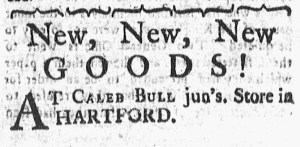What was advertised in a colonial American newspaper 250 years ago today?

“SILKS and superfine Broad-Cloths.”
Although John Barrett and Sons did not happen to adorn their advertisement in the Massachusetts Gazette and Boston Weekly News-Letter with a woodcut related to some aspect of their business, that did not mean that their notice lacked visual appeal. A border comprised of decorative type enclosed their advertisement for a variety of imported textiles and “All Kinds of English, Scotch, India, Hard-Ware and Cutlary GOODS.” Other typographical elements also helped draw attention to their advertisement. It featured a headline, “SILKS and superfine Broad-Cloths,” that highlighted some of the goods that readers would encounter in the advertisement. It alternated lines in larger and smaller fonts. In addition to the headline, three other lines – “A Prime Assortment of Padusoys,” “By JOHN BARRETT & SONS,” “All Kinds of English, Scotch” – appeared in larger type. An appeal to price, “to be sold at an exceeding low Rate,” utilized italics for emphasis. Overall, Barrett and Sons’ advertisement had a lively appearance.

The border certainly distinguished it from other notices, but many had their own distinctive visual elements to draw attention. An advertisement for the sloop Industry seeking freight and passengers for a voyage to New York was the only advertisement in the August 19, 1773, edition with a woodcut. The printer provided a stock image of a vessel at sea. Other advertisements had their own headlines in larger fonts, including “WHIPS,” “Fyal WINE,” and “Drugs & Medicines.” An advertisement for groceries and other goods sold “Next Door Southward of the Sign of the Buck and Gloves” divided the items into three columns, listing one item per line rather than clustering them together in a paragraph of dense text. Daniel Bell did not resort to columns in his advertisement; he (and the compositor) devised a different means of giving each item more space on the page, naming one or two items per line and centering them. That resulted in an amorphous and irregular shape about as different from the rectangle defined by the border of Barrett and Sons’ advertisement as possible. All of the advertisements in that issue of the Massachusetts Gazette and Boston Weekly News-Letter relied primarily on text rather than images, yet they did not lack visual images. The advertisers and compositors deployed typography that distinguished advertisements from the columns of news and from each other, creating a visual cacophony to engage readers and prospective customers.









